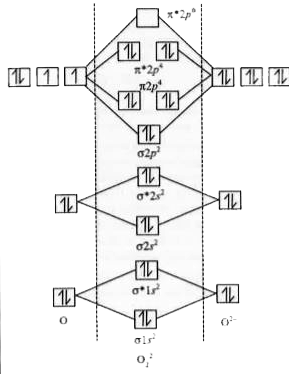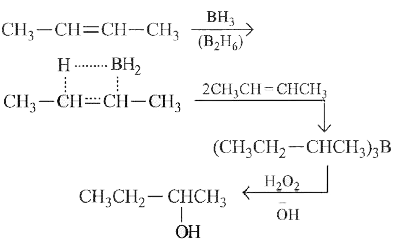Explore topic-wise InterviewSolutions in .
This section includes InterviewSolutions, each offering curated multiple-choice questions to sharpen your knowledge and support exam preparation. Choose a topic below to get started.
| 27401. |
The number of atoms in 0.004 g of magnesium is close to (atomic mass of Mg = 24) |
|
Answer» 24 0.004 g of Mg ` = (6 xx 10^23)/(24) xx 0.004= 1 xx 10^20` |
|
| 27402. |
The number of atoms belongs to bcc unit cell is ............................... |
|
Answer» 2 |
|
| 27403. |
The number of atom is an mole gas can be given by : |
|
Answer» `N XX "Av.no" xx "ATOMICITY"` |
|
| 27405. |
The number of asymmetric carbon atoms in fructose are : |
|
Answer» 2 |
|
| 27406. |
The number of asymmetric carbon atoms and the number of optical isomers inCH_(3)(CHOH)_(2)COOH are respectively :– |
|
Answer» 3 and 4 `2^(2)=4` |
|
| 27407. |
The number of asymmetric carbon atoms in a molecule of glucose is: |
|
Answer» 6 |
|
| 27408. |
The number of asymmetric C-atom created and number of possible stereoisomers when benzil (Ph CO CO Ph) is reduced with LiAlH_(4). |
|
Answer» `2,3`  The product CONTAINS two similar ASYMMETRIC carbon atoms and two OPTICALLY active and moreoptically inactive meso FORM. |
|
| 27409. |
The number of asymmetric carbon atom in glucose are |
|
Answer» 2 |
|
| 27410. |
The number of asymmetric carbon atom/sin lactic acid is |
|
Answer» 1 |
|
| 27411. |
The number of assymmetric carbon atoms in a molecule of glucose is |
|
Answer» 4 |
|
| 27412. |
The number of antibiotics among the following is ampicillin, sulphanilamide, veronal, equanil, serotonin, luminal, seconal. |
|
Answer» |
|
| 27413. |
The number of antibonding electron pairs in O_(2)^(2-) molecular ion on the basis of molecular orbital theory is(Atomic number of O is 8) |
|
Answer» 5  MOLECULAR orbital diagram of `O_(2)^(2-)`(SUPEROXIDE ion). |
|
| 27414. |
The number of anti - bonding electrons present in O_(2)^(-) molecular ion is : |
|
Answer» 8 No, of electrons in antibonding orbitals = 5 (excluding inner orbitals = KK). |
|
| 27415. |
The number of anions presentin bleaching powder. |
Answer» 
|
|
| 27416. |
The number of Amino acids in the two protomers of insulin are |
|
Answer» 21 |
|
| 27417. |
The number of amino acids found in proteins that a human body can synthesize is |
|
Answer» 20 |
|
| 27418. |
The number of amino acids in insulin is : |
|
Answer» 51 |
|
| 27419. |
The number of amino acids and numberof peptidebonds in a linear tetrapeptide (made of different amino acids) are respectively. |
|
Answer» 4 and 4 No. of PEPTIDE BONDS = No. of amino acids - 1 
|
|
| 27420. |
The number of aluminium ions present in 54g of aluminium (atomic weight27) is |
|
Answer» 2 `= (6.203 xx 10^(23) xx 54)/(27) = 1.2 xx 10^(24)` |
|
| 27421. |
The number of amino acid that human body can synthesise is |
|
Answer» 20 |
|
| 27422. |
The number of alpha-particles emitted per second by 1g of radium is 3.608 xx 10^(10). Calculate decay constant and t_((1)/(2)) |
|
Answer» SOLUTION :`1.35 XX 10^(-11)s^(-1)` `5.13 xx 10^(10)s` |
|
| 27423. |
The number of alpha beta -particles emitted in the nucleus reaction ._(92)U^(238) rarr ._(90)Th^(234) rarr ._(91)Pa^(234) are respectively |
|
Answer» 1 and 1 No. of `alpha" particle" = (238 - 234)/(4) = (4)/(4) = 1` No. of `beta " particle " = 91 - 90 = 1` |
|
| 27424. |
The number of alpha particle in the nuclear reaction ""_(90)^(238) Th to ""_(81)^(212) Bi are : ____ |
|
Answer» |
|
| 27425. |
The number of alpha- and beta-particles emitted when a radioactive element ._(90)E^(322) changes into ._(86)G^(220) will be |
|
Answer» Solution :`._(90)E^(232) rarr ._(86)G^(220)` No. of `ALPHA " particle " = (232 - 220)/(4) = 3` No. of `beta" particle " = 86 - [90 - 2 xx 3] = 2` |
|
| 27426. |
The number of alpha and pi-bonds present in the molecule of carbolic acid are respectively |
|
Answer» 7, 3 |
|
| 27427. |
The number of alpha and beta particles emitted in the nucleur disintegration series _90^228 Th to _83^213 Bi are: |
|
Answer» `8alpha,1beta` |
|
| 27428. |
The number of alpha and beta particles emitted in the nuclear reaction, ._(90)Th^(298) rarr ._(83)Bi^(212) are |
|
Answer» `4 alpha` and `7 BETA` |
|
| 27429. |
The number of alpha and beta-particles emitted in the nuclear reaction ._(90)Th^(228) rarr ._(83)Bi^(212) are respectively |
|
Answer» 4 , 1 No. of `ALPHA-"particle" = (228 - 212)/(4) = (16)//(4) = 4` No. of `BETA-"particle" = 2xx 4 - 90 + 83` |
|
| 27430. |
The number ofalpha and beta- particles emitted in the nuclear reaction Th_90^228 to Th_90^228 are respectively |
| Answer» ANSWER :A | |
| 27431. |
The number of alpha and beta-particles emitted during the transformation of ._(90)Th^(232) " to " ._(82)Pb^(208) are respectively |
|
Answer» 4, 2 Equating mass no. `232 = 208 + 4x + 0 y or 4x = 24 or x = 6` Equating atomic no `90 = 82 + 2x - y or 90 = 82 + 2 xx 6 - y or y = 4` Hence `6 alpha and 4 beta` particles will be emitted |
|
| 27432. |
The number of alpha and beta particles emitted during the transformation of ""_(90)Th^(232) to ""_(82)Pb^(208) are respectively |
|
Answer» Solution :`""_(90)Th^(232)to""_(82)Pb^(208)` Loss in weight=232-208=24. HENCE number of `alpha`-particles emitted=`(24)/(4)=6` Therefore, `""_(90)Th^(232) underset(-6a)to""_(78)X^(208) underset(-4beta)to""_(82)Pb^(208)` For increasing atomic no. by four units `4beta` particle must be emitted. |
|
| 27433. |
The number of alpha and beta emitted in the nuclear reaction ""_(92)^(238)U to ""_(82)^(214)Pb is |
|
Answer» `8 beta` `""_(92)^(238)U to x ""_(2)^(4)alpha + y ""_(-1)^(0)beta + ""_(82)^(214)Pb` Equating the MASS numbers on both sides, `238 = 4x + y xx 0 + 214 implies 4x = 24 :.x= 6` Equating atomic numbers on both sides, `92 = 2x + (-y) + 82` `92 = 2 xx 6 + (-y) + 82 implies - y = - 2 :. y = 2` HENCE in the NUCLEAR reaction, `""_(92)^(238)U to ""_(82)^(214)Pb, 6 alpha`- and `2 beta` - particles are emitted. |
|
| 27434. |
The number of alkene(s) which can produce 2-butanol by the successive treatment of (i) B_(2)H_(6) in tetrahydrofuran solvent and (ii) alkaline H_(2)O_(2) solution is |
|
Answer» Solution :STRUCTURE of butane-2-ol is: `CH_(3)- underset(OH) underset(|) CH-CH_(2)-CH_(3)`  Now, `CH_(3)-CH= CH-CH_(3)` can have both CIS and transforms. |
|
| 27435. |
The number of all possible products excluding stereoisomers obtained on monochlorination of n-butane and iso-butane are respectively |
|
Answer» 2 and 3 |
|
| 27436. |
The number of alkene(s) which can produces 2-butanol by the successive treatment of (i) B_2H_6 in tetrahydrofuran solvent and (ii) alkaline H_2O_2 solution is- |
|
Answer» 1 
|
|
| 27437. |
The number of alpha- and beta- particles emitted during the transformation of ""_(90)^(232) Th to ""_(82)^(208) Pb is respectively |
|
Answer» 2,2 ` 8 = (2 XX 6) -b, b = 12 - 8 beta` |
|
| 27438. |
The number of alkenes (including stereoisomers) which can produce 2 - butanol by the successive treatment of (i) B_(2)H_(6) in tetrahydrofuran solvent and (ii) alkaline H_(2)O_(2) solution is/are |
|
Answer» |
|
| 27439. |
Thenumberof alkanylgroupspossiblefromC_ 4H _ 7are |
|
Answer» 7 (i)` CH _ 3 - CH _ 2-CH =CH - ` (ii)`CH _3 -CH = CH-CH _ 2-` (iii )` CH _ 2=CH -CH _ 2-CH _ 2- ` (iv)` CH _ 3- underset (CH _ 3) underset(|) C -CH -` (v)` CH _3 - underset ( CH _ 2- ) underset ( |)C =CH ` |
|
| 27440. |
The number of alkanols and ethers represented by the molecular formulaeC_(3) H_(8) O and C_(4)H_(10) Orespectively are gives by the set : |
|
Answer» 2,1,3,2 
|
|
| 27441. |
The number of aldol reaction (s) that occurs in the given transformation is |
|
Answer» 1 |
|
| 27442. |
The number of aldol reaction(s) that occurs in the given transformation is |
|
Answer» 4 |
|
| 27443. |
The number of alcohols giving iodoform test among the following is CH_(3)CH_(2)OH,CH_(3)OH,CH_(3)CH_(2)CH_(2)OH,(CH_(3))_(2)CHOH CH_(3)CH_(2)CH_(2)CH_(2)OH,CH_(3)CH_(2)CH(OH)CH_(3) CH_(3)CH(OH)CH(CH_(3))_(2),(C_(2)H_(5))_(2)CHOH,(CH_(3))_(3)COH |
|
Answer» |
|
| 27444. |
The number of alcohols giving iodoform test among the following is: CH_(3) CH_(2) OH, CH_(3) OH, CH_(3) CH_(2) CH_(2) OH, (CH_(3))_(2) (CHOH), CH_(3) CH_(3) CH_(2) CH_(2) OH CH_(3) CH_(2) CH (OH)CH_(3), CH_(3) CH (OH)CH (CH_(3))_(2) (C_(2) H_(5))_(2) CHOH, (CH_(3))_(3) COH |
|
Answer» |
|
| 27445. |
The number of aldehydes of molecular formula C_5H_10O is : |
|
Answer» 2 |
|
| 27446. |
The number of acidic protons in H_(3)PO_(3) are |
|
Answer» 0 
|
|
| 27447. |
The number of alcohol isomers for molecular formula C_(4)H_(10) is _______. |
|
Answer» 7 |
|
| 27448. |
The number of acidic protons in H_3PO_3 are : |
|
Answer» 0 |
|
| 27449. |
The number of a-particles emitted by ""^(218)Ra in changing to stable isotope ""^(206)Pb is : |
|
Answer» 3 Comparing MASS NUMBERS `218=206+4x+0` 4x=12 or x=3 |
|
| 27450. |
The number of a bonds in the product formed in acid catlysed reaction of acetaldehyde ---- |
|
Answer» |
|